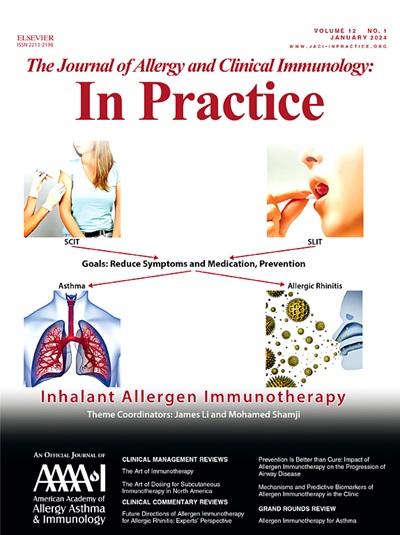How Airway Caliber Affects FeNO Thresholds Used to Identify Type 2 Inflammation in Asthma
IF 6.6
1区 医学
Q1 ALLERGY
Journal of Allergy and Clinical Immunology-In Practice
Pub Date : 2025-09-01
DOI:10.1016/j.jaip.2025.05.049
引用次数: 0
Abstract
Background
Fractional exhaled nitric oxide (FeNO) has emerged as a biomarker of type 2 (T2) airway inflammation (AI), primarily reflecting IL-13 activity. Reducing airway caliber reduces FeNO levels, suggesting an impact of airway obstruction.
Objective
This study compared the relative contributions of airway IL-13 and airway caliber to FeNO values in patients with asthma. We also investigated how airway caliber reduction affects FeNO thresholds for detecting active T2 AI.
Methods
FeNO and forced expiratory volume in 1 second (FEV1) measurements as well as sputum induction were performed in 120 patients with asthma and 13 controls. Elevated sputum IL-13, IL-5, or eosinophils identified 100 patients with active T2 AI. The contributions of IL-13 and FEV1 to FeNO were assessed in asthmatics with clear evidence of T2 AI by multivariable linear models. Receiver operating characteristic (ROC) curve analysis was used to identify FeNO thresholds marking the presence of active T2 AI according to FEV1.
Results
In T2 patients, IL-13 and FEV1 contribute significantly (P = .005 and P = .008, respectively) to FeNO based on multivariable analysis. From the ROC curve analysis, the FeNO threshold corresponding to a specificity >85% was 45 parts per billion (ppb) in the whole population and dropped to 22 ppb in patients with FEV1 <70%.
Conclusions
Airway caliber is a major determinant of FeNO values in asthma, as crucial as concomitant T2 AI. As a result, the optimal thresholds for FeNO to signal the presence of active T2 AI in asthmatics decrease significantly as FEV1 decreases. New thresholds considering the impact of lung function should be established in larger cohorts.
气道口径如何影响用于识别哮喘2型炎症的FENO阈值。
背景:呼气一氧化氮分数(FENO)已成为2型(T2)气道炎症(AI)的生物标志物,主要反映IL-13活性。气道口径减小可降低FENO水平,提示气道阻塞的影响。目的:比较哮喘患者气道IL-13和气道口径对FENO值的相对贡献。我们还研究了气道口径减小如何影响检测活动性T2气道炎症的FENO阈值。方法:对120例哮喘患者和13例对照组进行FENO、FEV1测定和痰液诱导。痰中IL-13、IL-5或嗜酸性粒细胞升高确定了100例活动性T2气道炎症患者。采用多变量线性模型评估具有明显T2气道炎症证据的哮喘患者IL-13和FEV1对FENO的贡献。采用ROC曲线分析,根据FEV1确定FENO阈值,判断是否存在活动性T2气道炎症。结果:多变量分析显示,2型患者IL-13和FEV1对FENO有显著影响(p=0.005和p=0.008)。从ROC曲线分析,FENO阈值对应于特异性>85%,在整个人群中为45 ppb。结论:气道口径是哮喘患者FENO值的主要决定因素,与伴随的T2气道炎症一样重要。因此,随着FEV1的降低,哮喘患者FENO指示活动性T2气道炎症存在的最佳阈值显著降低。考虑到肺功能影响的新阈值应该在更大的队列中建立。
本文章由计算机程序翻译,如有差异,请以英文原文为准。
求助全文
约1分钟内获得全文
求助全文
来源期刊

Journal of Allergy and Clinical Immunology-In Practice
ALLERGYIMMUNOLOGY-IMMUNOLOGY
CiteScore
11.10
自引率
9.60%
发文量
683
审稿时长
50 days
期刊介绍:
JACI: In Practice is an official publication of the American Academy of Allergy, Asthma & Immunology (AAAAI). It is a companion title to The Journal of Allergy and Clinical Immunology, and it aims to provide timely clinical papers, case reports, and management recommendations to clinical allergists and other physicians dealing with allergic and immunologic diseases in their practice. The mission of JACI: In Practice is to offer valid and impactful information that supports evidence-based clinical decisions in the diagnosis and management of asthma, allergies, immunologic conditions, and related diseases.
This journal publishes articles on various conditions treated by allergist-immunologists, including food allergy, respiratory disorders (such as asthma, rhinitis, nasal polyps, sinusitis, cough, ABPA, and hypersensitivity pneumonitis), drug allergy, insect sting allergy, anaphylaxis, dermatologic disorders (such as atopic dermatitis, contact dermatitis, urticaria, angioedema, and HAE), immunodeficiency, autoinflammatory syndromes, eosinophilic disorders, and mast cell disorders.
The focus of the journal is on providing cutting-edge clinical information that practitioners can use in their everyday practice or to acquire new knowledge and skills for the benefit of their patients. However, mechanistic or translational studies without immediate or near future clinical relevance, as well as animal studies, are not within the scope of the journal.
 求助内容:
求助内容: 应助结果提醒方式:
应助结果提醒方式:


